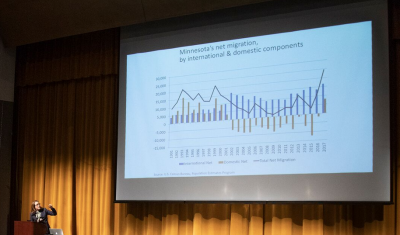MCPA Statement Regarding Minnesota Supreme Court Ruling
 The MCPA is disappointed by the Minnesota Supreme Court’s decision in the case of the city of Richfield vs. Law Enforcement Labor Services, Inc. We believe the state’s highest court missed a unique opportunity to help law enforcement leaders across Minnesota improve the policing profession. The MCPA is disappointed by the Minnesota Supreme Court’s decision in the case of the city of Richfield vs. Law Enforcement Labor Services, Inc. We believe the state’s highest court missed a unique opportunity to help law enforcement leaders across Minnesota improve the policing profession.
Had the Supreme Court upheld the Minnesota Appeals Court ruling that the city was justified in its termination of officer Nate Kinsey, municipal leaders would have more leeway to terminate employees who fail to follow policy and display a pattern of disciplinary problems.
Our association will continue to explore ways to address this issue and we applaud the city of Richfield and the leadership of its police chief. Together, they are taking the appropriate steps to ensure the officer returns to work with the proper training that will help maintain the public’s trust in its agency.
Statement from Andy Skoogman, Executive Director of the Minnesota Chiefs of Police Association, February 13, 2019 |
A day spent in our boots
 Students from the Orono High School forensics class spend a day in training with local police. What is it really like to handle everything from evidence to a critical incident? Students from the Orono High School forensics class spend a day in training with local police. What is it really like to handle everything from evidence to a critical incident?
By Andrew Wittenborg | MCPA
As traffic stops go, this one looks more chaotic than usual. For one thing, the driver will not stop talking. He keeps going on and on about how he’s seen it all before with the cops. It also does not help that the officer cannot stop laughing. “Do you know why I stopped you,” she asks in between giggles. “You did not come to a complete stop at that intersection back there.
 And so goes another scenario at Forensics Day inside the Orono Police Department. The annoying driver is actually Orono Sergeant Chad Stensrud, a guy fellow officers say gives Oscar worthy performances. The officer who has “stopped” him is an Orono High School student. Nearly 60 students have made the trip across the street from their campus to spend the day with officers from both Orono and West Hennepin Public Safety. And so goes another scenario at Forensics Day inside the Orono Police Department. The annoying driver is actually Orono Sergeant Chad Stensrud, a guy fellow officers say gives Oscar worthy performances. The officer who has “stopped” him is an Orono High School student. Nearly 60 students have made the trip across the street from their campus to spend the day with officers from both Orono and West Hennepin Public Safety.
“This program started out as a relationship building opportunity and an educational setting to help the students understand law enforcement a little better,” says West Hennepin Sergeant Rick Denneson. “As the years have gone by, we have slowly built on that fact that the police are people too. You do not have to have some super human power or have the ability to be downloaded with robotic functioning to perform our job.”
The officers say they see the day as good community outreach. Students who show any interest in a public safety career are an added bonus.
“Many times, kids who may have never seen themselves in law enforcement get the bug by the end of this program,” says Orono Officer Jason Barnes, who is also one of his department’s two school resource officers. “If you watch, you can see their interest level and confidence build as they pass through each station.”
Over the course of the day, students will work their way through four stations practicing traffic stops, use of force scenarios, examine SWAT equipment and watch Plymouth Officer Matt Glinian and his K-9 partner Stryker search a room for narcotics. They will also hear from chiefs Correy Farniok and Gary Kroells as well as a Hennepin County medical examiner.
“Law enforcement is so closely tied to forensics science that it is a natural fit for our class,” says Jessica Curtis, who teaches the course at Orono High School. “We have two former chiefs of police that are guest speakers in my class during the semester who discuss cyber forensics and people’s rights, the Fourth Amendment, and the history of Supreme Court cases that have led to how and when we collect evidence.
“Probably one of the biggest changes has been getting more students involved in the hands-on portion of the program,” Denneson says. “We make the scenarios as realistic as possible but, yet, keeping the opportunity for them to laugh at themselves and each other as they go through the programs.”
Inside the public works garage, Denneson acts as a coach giving each student about a minute’s worth of both pep talk and instruction. Like any officer responding to a vague 9-1-1 call, the students cannot be sure just what awaits them on the other side of the wall.
“Sir, please put your hands where I can see them,” one of the students commands as he approaches an uncooperative individual. The guy – in this case a West Hennepin officer – reaches for something and “shots” are fired. The incident is over in a matter of seconds, but not the discussion about what just took place.
“What do you think of our ‘officer’s’ response in this case,” Denneson asks. Over and over again, classmates standing by and watching, act as judge and jury and discuss how each case was handled and whether it could have been resolved differently.
Denneson tells them he loves his job but sometimes it is scary. “No matter how long you have been on the job, we have, at one point, all held each other and cried at a call because of a tragedy or someone we could not help in time. We are human. The overwhelming majority of people that we serve support us, appreciate us, and want us out there doing the job.”
For the students, the day offers plenty of eye-opening experiences. But this is also a science class, where they are studying evidence and procedure. Barnes, who has taught at Forensics Day for a couple of years and now organizes it, says the format receives good reviews.
“I would like to maintain the core including the use of force, traffic, the M.E. and SWAT. However, I am open to incorporating other aspects of law enforcement in the future, including the FBI, State Patrol and Crime Lab.”
Both agencies hoped the visits would work to improve police relations with local teenagers and believe they are accomplishing that goal. “It has to be fun,” Denneson says. “There is a lot of seriousness in our work but we always try to make whatever we can fun at work too.” |
|
CLEOs Consider New Strategies to Recruit & Retain Officers
From technology to healthcare to policing, it's hard to find a profession that will not face challenges recruiting and retaining its workforce. While Minnesota tends to perform better than its neighbors, the availability of workers will continue to slow over the next 10 years. That's just one of the projections Minnesota state demographer Susan Brower offered at MCPA's annual Critical Issues Forum.
 "We need to start thinking about who are the people who could potentially have an interest in policing and development strategies to prepare them for a career in law enforcement," she told an audience of police chiefs and law enforcement leaders at Bloomington's Schneider Theater. "We need to start thinking about who are the people who could potentially have an interest in policing and development strategies to prepare them for a career in law enforcement," she told an audience of police chiefs and law enforcement leaders at Bloomington's Schneider Theater.
Brower covered three strategies in her presentation that law enforcement might consider as it plans for a future generation of officers. The first involves more long term planning, a review of current police officer requirements and finally the adoption of new strategies to pull in more people who are not currently in the workforce. She said all of these are necessary because people leaving the workforce through retirement or other factors are not being replaced by an equal number of candidates. Any of stability in the available Minnesota workforce is due to the growth of international immigration. generation of officers. The first involves more long term planning, a review of current police officer requirements and finally the adoption of new strategies to pull in more people who are not currently in the workforce. She said all of these are necessary because people leaving the workforce through retirement or other factors are not being replaced by an equal number of candidates. Any of stability in the available Minnesota workforce is due to the growth of international immigration.
"We are kind of assuming at this point that we're going to have about the same levels of immigration as we've had in the past and that's a bit of a question mark at this point if that will continue," Brower said referring to state and federal immigration policy dates.
 According to a survey of by the Police Executive Research Forum (PERF), nearly 66 percent of police departments in the U.S. say their number of job applicants has decreased. Findings from the Bureau of Justice Statistics indicate that the raw number of sworn officers is also down from a peak of approximately 723,000 in 2013 to about 701,000 today. In Minnesota, the number of people who are taking the peace officer licensing exam annually has dropped more than 25% since 2015, and the number of people who have passed the exam has dropped 23% over that same time period, according to data from the Minnesota Police Officer Standards and Training Board (POST). According to a survey of by the Police Executive Research Forum (PERF), nearly 66 percent of police departments in the U.S. say their number of job applicants has decreased. Findings from the Bureau of Justice Statistics indicate that the raw number of sworn officers is also down from a peak of approximately 723,000 in 2013 to about 701,000 today. In Minnesota, the number of people who are taking the peace officer licensing exam annually has dropped more than 25% since 2015, and the number of people who have passed the exam has dropped 23% over that same time period, according to data from the Minnesota Police Officer Standards and Training Board (POST).
Brower encouraged chiefs to consider longer term employment strategies. "How do we find people earlier and bring them along to where we need them to be in 5 years," she said. "It is a much longer training period than the typical application period. She also said some employer groups have decided to update and review job requirements with an eye toward deciding which ones are absolutely necessary. "Where do you have flexibilty in designing workforce standards and jobs?"
While Minnesota's 10,000 peace officers work mostly for local agencies, Minnesota requirements include a test, licensure and training standards that must be met every few years to renew the license.
Workforce participation remains a challenge across the U.S. economy. Brower shared data that supports some people are not looking for work because of pay while others, especially parents and caregivers, find it difficult to re-enter the workforce after leaving for a time to take care of family. For some employer groups, this is about growing your own workforce by better aligning and preparing people for the jobs you will have available. She also pointed to careers where employers can show applicants there is a structure in place and not just the promise of advancement.
"When I talk to employers who say they are not having problems hiring, they have created concrete opportunities with pathways for moving up," Brower said.
MCPA will continue to explore the law enforcement workforce issue at events throughout 2019. Gordon Graham, of Lexipol, will speak on the topic at the Executive Training Institute in St. Cloud in April.
|
Maximizing the Value of Pre-employment Psychological Screening for Police Officers
by Gary L. Fischler, Ph.D, ABPP, and Kiri A. Faul, Ph.D.
According to the Minnesota POST Board, established minimum selection standards are to be followed during the hiring process for police officers. The MN POST (6700.0700, Subpart 1., I) requires that the pre-employment evaluation be conducted by a licensed psychologist and include an oral interview. While at times law enforcement administrators may view this process as only a routine, perhaps burdensome, hurdle, when performed properly, pre-employment psychological evaluations (PEPE) can yield a great deal of important, sometimes critical, information for police agencies.
So, how do agencies use PEPEs in the most effective way to ensure that this requirement adds incremental value and increases the overall efficiency of the agency? The most effective PEPEs will:
- Use the correct screening criteria. It is critical that your evaluator use a job suitability standard versus a psychological disorder or condition standard because most individuals who are found unsuitable for law enforcement duties do not have psychological disorders, and many who have had problems can be suitable for law enforcement.
- Use the most valid tests. The tests that have been most thoroughly researched and validated for law enforcement screening are the most recent form of the Minnesota Multiphasic Personality Inventory (MMPI-2-RF) and the California Psychological Inventory (CPI).
- Maximize the predictive value of the tests by using the best cut scores. Cut scores developed for general use are not adequate. Only cut scores designed specifically for screening law enforcement applicants can provide the most accurate prediction of a candidate’s success as a law enforcement officer.
- Be within the bounds of the Americans with Disabilities Act (ADA), Genetic Information Nondiscrimination Act (GINA), and related statutory and case law. Recent alleged violations in MN legal cases emphasize the importance of attending to these laws.
- Maintain consistency with important professional standards and guidelines. The MN POST Board and International Association of Chiefs of Police – Police Psychological Services Section (IACP-PPSS) have both established recommended guidelines for PEPEs.
- Maximize diversity. The PEPE process should not result in adverse impact to ethnic, racial, gender, or other specific groups of applicants. The process should also use cultural competence and the absence of bias as important screening criteria for applicants to insure that they can work well with the diverse members of the communities they serve.
- Be conducted only by psychologists who are specialists in Police and Public Safety Psychology. This is an important distinction included in the IACP-PPSS guidelines. The American Psychological Association (APA) and American Board of Professional Psychology (ABPP) have recognized police and public safety psychology as an area of specialty practice. Not all psychologists are fully qualified to provide this specialized service.
When used properly, the PEPE process screens out some law enforcement candidates (about 15%) who may not meet the suitability requirement of the agency. Based on our research and other information, when performed with state-of-the-art techniques by examiners who are law enforcement specialists, screening out these candidates can result in:
- Long-term reduction of sustained citizen complaints.
- Reduction of stress-related psychological injuries.
- Maximization of officers’ positive relationships with citizens, and teamwork with coworkers and supervisors.
- Elimination of costly errors of judgment.
- Reduction of excessive force incidents and abuse of authority.
- Reduction of other disciplinary issues, including probability of termination.
- Maintenance of the highest standards of integrity, dependability, and reliability.
For further information on how to get the most out of your PEPEs, please visit our website (www.psycheval.com) to view our recent webinar and browse our library of articles, professional guidelines, and other resources, or call us at 612-333-3825.
Dr. Gary L. Fischler earned a doctorate in Clinical Psychology from the University of Minnesota in 1984. He is a Board Certified Specialist of the American Board of Police and Public Safety Psychology and a member of its Board of Directors, serving as its National Chair of Examinations. He is an adjunct assistant professor of psychology at the University of Minnesota and has served as the chair of the University of Minnesota Press Advisory Board, Test Division. Dr. Fischler's special interests relate to the interface between psychology, legal issues, and workplace concerns, and he has authored or co-authored several publications on these topics.
Dr. Kiri A. Faul earned her Ph.D. in psychology from the University of North Dakota in 2006. Since 2008, her primary specialty has been working as a Police and Public Safety Psychologist, conducting over 2000 Pre-employment Evaluations, Leadership & Management Assessments, and Fitness-for-Duty Evaluations. She also provides mental health and wellness services to public safety agencies. Dr. Faul’s special interests relate to PTSD and trauma stress responses. She is an active member of IACP-PPSS, having served as a member of its Education Committee for the annual IACP conference. In addition to Police and Public Safety, she provides evaluations in the areas of Social Security Disability, VA disability, family court, and private Independent Psychological Medical Evaluations.
|
|